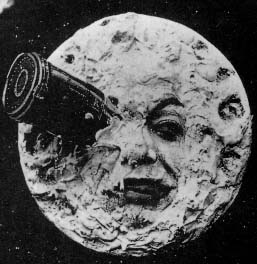Lunacy, Part III

So, humans have been going to the moon, literally, since 1902. In the movies at least. It's easy to understand why film makers would want to speculate about what it would be like to visit our satellite and what, if anything might live there. I won't bore you with the more recent lunamatic (film studies of, well, you know) efforts that are realistic and/or historical (Apollo 13, for example). The more interesting films were made when humans knew far less about our celestial neighbor than we do now and engaged in greater flights of fancy.
The 1902 adventure was called, not very imaginatively I admit, A Trip to the Moon, although the original French title (Le Voyage dans la lune) conveys a bit more "joie de planetoid." A Trip to the Moon was written, directed, and starred in by George Melies. It is a silent film, shot in black and white and then hand colored. To create his story, Melies cribbed from various authors, including Jules Verne. As you might know, the adventurers, led by the indomitable Professor Barbenfouillis, become the world's first cannonauts as, according to Wikipedia, "a space capsule in the shape of a bullet is built, along with a huge cannon to shoot it into space. The astronomers embark and their capsule is fired from the cannon with the help of 'marines,' most of whom are played by young women in sailors' outfits." In typical human behavior, the cannonauts run into, PO, and then escape from the resident "insectoid" Selenites (Selene is the Greek goddess of the moon), taking one captive that they later put on display during a celebratory welcome-home parade.
On Melies moon, the Earthlings do not need spacesuits, camp out on the surface with just blankets, take shelter from a snowstorm in a cave filled with giant mushrooms, and witness one of their umbrellas morphing into one of the said mushrooms, which leads one to conclude that the cannonauts were tripping in more ways than one.
How did our adventurers return home, you might ask. Professor Barbenfouillis simply, all by himself, "tips the capsule over a ledge on the Moon" and "astronomer, capsule, and [hapless] Selenite fall through space and land in an ocean on Earth, where they are rescued by a ship and towed ashore." Of course.
In the equally fanciful First Men in the Moon (1964), taken from the H.G. Wells novel, a group of astronauts arrive on the Moon in that year and discover that someone has planted a Union Jack and claimed it for Queen Victoria. This film's Victorian adventurers, packing among other things an elephant gun, reach the Moon courtesy of a vehicle powered by Cavorite, which nullifies gravity, also find the Selenites, also piss them off, and then escape, but not before dooming the moon dwellers to death by leaving the common cold virus behind. Previous to the POing, the Selenites' "Grand Lunar" hypothesizes that the Earth's lack of a single ruler like itself might cause confusion. One of the Earthlings admits, "Yes, it does. And worse. Starvation... hostility... even war." The GL then declares that anyone who makes war is "defective," and the Earthling responds with his version of the famous "nobody's perfect" line from Some Like It Hot. He might well have just said, "Let the POing commence."
In today's world, NASA is preparing the Artemis missions to return astronauts to the Moon. At the same time, a company in Texas is building an apparatus that will 3D print a landing pad and habitats for humans to live there. One hopes that when they meet the Selenites, as they no doubt will, they are smart enough to not mention our imperfections, leave their elephant guns behind, and pack a large supply of Dayquil.
(Image: Screenshot from A Trip to the Moon, 1902. Public domain.)

Comments
Post a Comment